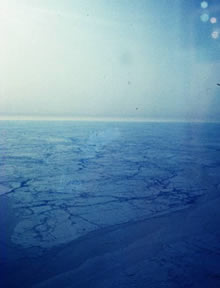
 |
Dirty snow heats ArcticJune 10, 2007Courtesy of Far North Science 
Arctic Haze distributes soot As any Far North resident knows well, dirty snow melts faster. But what about the Arctic Ice and Far North climate, where the Earth has been warming many times faster than the rest of the globe? A team of scientists from the University of California Irvine have confirmed what common sense predicts: the soot-stained polar ice and snow has become a major driver of Arctic warming, perhaps explaining up to one-third of the warming most studies blame on greenhouse gases like carbon dioxide. "It's like placing tiny toaster ovens on the snow pack," said scientist Charlie Zender, in a UCI story about the study, the first to take into account forest fires and estimate the full impact of fall-out on warming. Unlike much of the climate science that hinges on gig-busting supercomputer programs and rocket-science complexity, the relationship between warming and soot is as fundmental as road dirt. Snow becomes dirty when soot from tailpipes, smoke stacks and forest fires enters the atmosphere and falls to the ground. Soot-infused snow is darker than natural snow. Dark surfaces absorb sunlight and cause warming, while bright surfaces reflect heat back into space and cause cooling. "When we inject dirty particles into the atmosphere and they fall onto snow, the net effect is we warm the polar latitudes," said Zender, associate professor of Earth system science at UCI and co-author of the study. "Dark soot can heat up quickly."
Annual mean temperature change due to dirty snow in degrees Celsius Credit: Charlie Zender In the study, Present-day climate forcing and response from black carbon in snow, published this week in the Journal of Geophysical Research, Zender and graduate student Mark Flanner calculated that dirty snow caused the Earth's temperature to rise .1 to .15 degree, or up to 19 percent of the total warming of about .8 ° C since the Industrial Revolution began pumping CO2 and other greenhouse gases into the air. Other contributers were UCI scientist James Randerson and climate modeler Philip Rasch, with the National Center for Atmospheric Research in Boulder, Colo. The National Science Foundation and NASA paid for the study. As the Arctic Climate Impact Assessment has pointed out, the Arctic has warmed about twice as fast during the past two centuries, as much as 1.6 °C. Here's the remarkable finding: Dirty Arctic snow triggered .5 to 1.5 ° C of the Arctic warming - as much as 94 percent of the rise in temperatures. The UCI story explains further: The amount of warming by dirty snow varied from year to year, with higher temperatures in years with many forest fires. Greenhouse gases, which trap outgoing energy, are primarily responsible for the remaining temperature increase and are considered the Earth's most important overall climate changing mechanism. Other human influences on Arctic climate change are particles in the atmosphere, including soot; clouds; and land use. Humans create the majority of airborne soot through industry and fuel combustion, while forest and open-field fires account for the rest. Because of human activity, greenhouse gas levels have increased by one-third in the last two centuries. "A one-third change in concentration is huge, yet the Earth has only warmed about .8 degrees because the effect is distributed globally," Zender said. "A small amount of snow impurities in the Arctic have caused a significant temperature response there." |
|